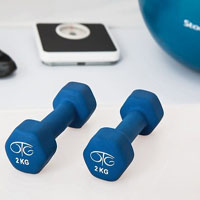 Smart Citations
Smart CitationsSee how this article has been cited at scite.ai
scite shows how a scientific paper has been cited by providing the context of the citation, a classification describing whether it supports, mentions, or contrasts the cited claim, and a label indicating in which section the citation was made.
Perceived fatigue, lower limb muscle force and performance fatigability after a rehabilitation program in Multiple Sclerosis
Muscle weakness and fatigue represent frequent disabling symptoms for Multiple Sclerosis (MS) patients. We evaluated the effects of an intensive task-oriented circuit training (TOCT) on perceived fatigue, muscle strength and changes in motor performance fatigability in mildly impaired MS patients. Fifteen MS patients performed different functional scales, self-reported questionnaires and instrumental evaluations before (T0) and after (T1) TOCT. Strength and performance fatigability were analyzed during isometric knee extension and ankle dorsiflexion through an isokinetic dinamometer, recording surface EMG signals of Vastus Medialis and Tibialis Anterior. The Dinamic Gait Index, Multiple Sclerosis Impact Scale-29, Modified Fatigue Impact Scale and Multiple Sclerosis Walking Scale–12 significantly improved after training. An increase of exerted force during isometric knee extension was observed, whereas no significant changes were revealed on mechanical and electrical fatigue. Moreover, the improvement in perceived disability after treatment was related to strength increase in knee mechanical force output. The TOCT positively modifies perceived fatigue, perceived ambulatory function and knee force output in mildly impaired MS subjects, suggesting a virtuous circle between strength levels, recovery of functional skills and improved quality of life.
Downloads
How to Cite
PAGEPress has chosen to apply the Creative Commons Attribution NonCommercial 4.0 International License (CC BY-NC 4.0) to all manuscripts to be published.

 https://doi.org/10.4081/ejtm.2020.9353
https://doi.org/10.4081/ejtm.2020.9353





